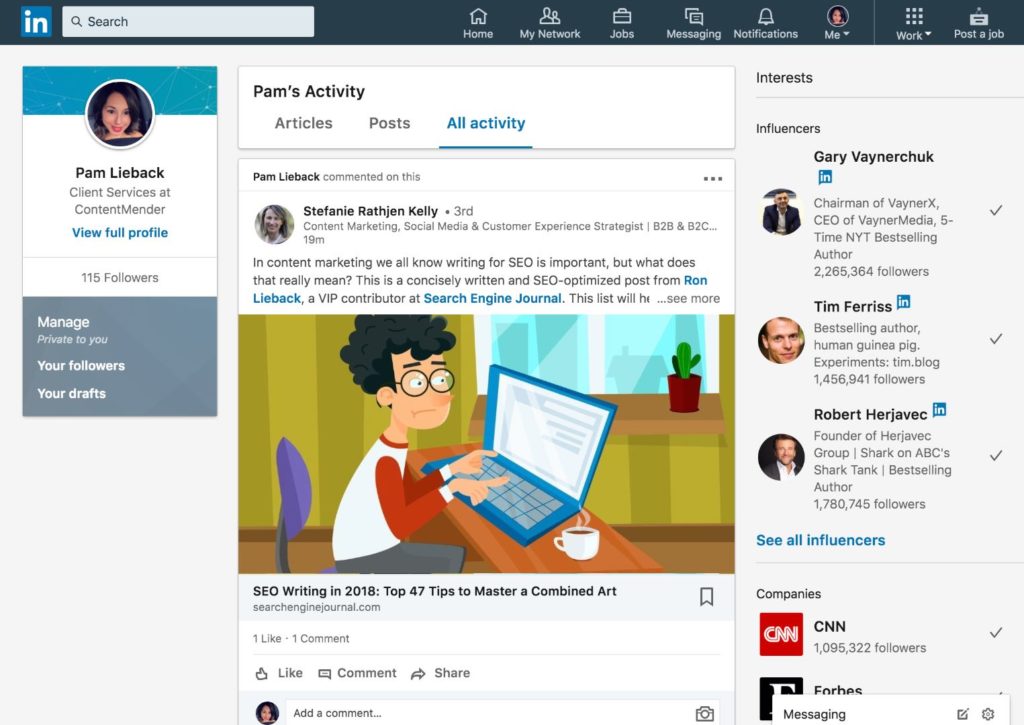Amplify Brand Awareness on LinkedIn & Medium
There is this underlying notion that content is best used to increase things like organic traffic and therefore is inherently something that should exist only on your website or blog. And while great content is absolutely part of a solid SEO strategy, it’s far from limited to a life of algorithms and SERPs.
Instead, content, which can invoke notions of credibility and expertise, must also play a primary in growing brand awareness.
For many businesses, social networks like LinkedIn and Medium are synonymous with brand awareness, and when content is appropriately leveraged among those audience members, the ROI can be incredible.
If you’re in the process of putting together your next brand campaign, then consider these tactics.
1. Keep Your Page Up-to-Date
Everything that follows will be relatively useless if it’s incomplete. Driving brand awareness through content is an excellent way to gain credibility, but if your page is missing information (contact info, business summary, images, URL, etc.) your efforts won’t get you very far.
Even if your page is updated with basic information, one that remains stagnant can also leave visitors second-guessing. As such, develop a regular posting strategy, but make sure it’s manageable. Consider your content needs as well as your resources and settle on a plan that allows you to post quality content at regular intervals.
2. Engage
Let’s be honest. You put your business on LinkedIn and Medium because in today’s ultra-digital world if you want to be seen as a credible business and network with companies and customers around the world, you have little choice. But just because these platforms are predominately used to increase revenue doesn’t mean you need to or should treat them exclusively as such.
One of the best ways to build your brand and design a content strategy is to engage with your followers and enter into the bigger conversation.
Relevant trends among your audience base, common problems and the solutions you offer can grow awareness and long-term relationships, even if that content is not directly related to your product or service. It’s also important to think about “who,” meaning how you can connect your content with influencers in your space.
When you approach every single post as a sales window, your followers will likely write you off as hungry for sales. When you enter the bigger conversation and provide valuable, insightful, and honest content, then you establish your brand as one that is knowledgeable and trustworthy.
3. Defining & Leverage Influencers
Influencers are frequently thought to be celebrities or high-profile social media users whose companies you can pay or barter with in exchange for an endorsement; however, on LinkedIn or Medium, those influencers most frequently take the shape of industry leaders or even past and existing clients.
When you spark relationships with these influencers, you expose your brand to an even wider audience while gaining trust by proxy.
 4. Be Real
4. Be Real
If there is one thing that drives me crazy when it comes to social media efforts, it’s a complete lack of authenticity. I’m not alone. In a 2017 Consumer Content Report conducted by Stackla, 90% of Millennials, 85% of Gen Xers, and 80% of Baby Boomers claimed that authenticity in marketing matters.
Your goal, like any other business, is likely to increase followers, market share, and eventually revenue, but if you want to do that, the story you tell must be real and it must translate to the audience.
It’s great to pitch a product or service here and there, but if you’re ending every post with a pitch or using a cookie-cutter approach to your social media strategy, you’re likely losing far more followers than you’re gaining.
This ties in closely with engagement, as the content you choose to share on these networks should be content that is authentic and speaks to the needs, concerns, and challenges that face your target audience.
5. Identify Your Objectives
Are you exclusively trying to gain brand awareness? Or, are you trying to build SEO? LinkedIn and Medium are great places to do the first, but they may not help you achieve your SEO goals.
For that reason, your content should be built around the intended platform use – presenting yourself and your brand as a knowledgeable and credible force in your industry.
If your primary goal is SEO, focus on your site content, and then skip down to the republishing tip at the end of this page.
6. Plan for the Whole Package
Our feeds are teeming with content. Some of it is great, and the rest of it…eh, not so much. But how do you know what to click on? Which content earns your chunk of precious time?
Chances are, there are a few key factors that determine whether or not you take a second glance as you scroll. An article title, the image that accompanies it, and even the quote or post used to draw attention to the content you share is important and thus cannot be overlooked.
Thumbnails, images, titles, accompanying posts all need to become part of your LinkedIn and Medium planning process if you want to increase the number of audience members that stop, click, and hopefully engage.
7. Give a Little Bit
It wouldn’t be wise to give away valuable trade secrets or proprietary information, but that doesn’t mean you can’t produce helpful content that helps your audience address comment problems at the surface of your field of expertise. Take a catering company, for example.
They can easily gain some awareness by publishing articles on how to throw the best office party this holiday season, but that doesn’t mean readers are going to DIY it. Instead, as those readers go on to the planning phases for their festive gatherings, they will likely think back to the company that offered those tips.
In many cases, these types of articles could boost brand awareness by showcasing your knowledge, which inherently adds to your credibility.
8. Use Tags & Filters
It’s rare that a business only has one, well-defined audience. Instead, most have a general audience that can be broken down into more specific segments based on need, type, budget, etc. Your social network strategies should address that.
Both LinkedIn Pulse and Medium offer users the ability to tag and filter and doing so can help you reach the target audience for which your content is best suited. It also means that you can drill down to specific needs without inundating your audience with post after post of irrelevant info.
9. Go Long
You may be tempted to keep posts simple or consistently share links from your own site, and while that’s great, don’t forget the importance of publishing your own long-form content.
LinkedIn Pulse – a LinkedIn app that delivers news customized to your tastes – offers members the opportunity to publish directly within the platform, allowing you to easily and quickly get content out in front of your followers.
Medium, which is designed specifically for the dissemination of well-cultivated content will do the same. Leverage that features.
10. Republish Existing Content
I saved this one for last because it’s a bit more detailed, so bear with me…
Even if you are publishing on LinkedIn or Medium, you likely are still creating and posting (and paying for…) content on your blog or website. That’s great, and certainly, a practice that can help you organically increase traffic – assuming it’s well crafted and done with SEO metrics in mind – but when your content only exists on your site, you lose out on a wider audience.
Your website or blog may be the most logical place to keep content, but that doesn’t mean it’s always getting the audience it deserves. For that reason, you may want to consider re-publishing content on LinkedIn Pulse or Medium in order to increase your brand awareness.
Now, here’s the thing – there’s a lot of feedback and advice out there about re-posting. Much of that is centered around the dreaded “duplicate content.” Is there somewhat of a risk associated with reposting? Yes. Is it significant enough to shut down this strategy? I tend to stand with some top experts, like Neil Patel, and say, no.
If you are going to re-publish, there are some things you should keep in mind, many of which can help you fend off any issues with duplicate content, which, for the record, is not a named penalty in the court of Google.
- Don’t immediately republish: If you want to leverage content on LinkedIn or Medium and still use it on your site, then post on your site first and then way a week or two before you publish on either network. This gives Google time to recognize the original source of the content.
- Use a teaser: You don’t need to publish the entire piece on LinkedIn or Medium. Instead, you can post a few paragraphs – make sure they’re enticing enough – and then have readers click to “keep reading.”
- Revamp content: In some cases, you may be able to revisit the content and rewrite it to offer a new view or a new approach to the topic, audience, or call to action.
LinkedIn and Medium are fantastic tools that can boost brand awareness and solidify trust and credibility. These tactics, when paired with well-crafted content, can take your business to the next level, helping you reach long-and short-term revenue and growth goals.





